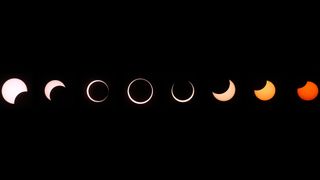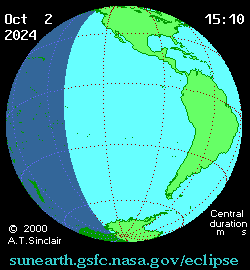When is the next solar eclipse?
The next solar eclipse will be on Oct. 2, 2024.

The next solar eclipse will be an annular solar eclipse on Oct 2, 2024, and will be visible over parts of the Pacific Ocean, southern Chile and southern Argentina.
A solar eclipse occurs when the moon is positioned between Earth and the sun and casts a shadow over Earth. They can only occur during the phase of the new moon and make for an interesting skywatching target.
During an annular solar eclipse, the moon appears slightly smaller than the sun, so it can't block the entire disk. The result is a beautiful "ring of fire." Only about 175,000 live within the path of annularity for the Oct. 2 eclipse according to Time and Date.
To keep up to date on all our solar eclipse coverage head on over to our solar eclipse live updates page.
Related: What's the difference between a total solar eclipse and an annular solar eclipse?

The second solar eclipse of 2024 will be an annular "ring of fire" solar eclipse visible in South America.
To see all the phases of the eclipse including the famous "ring of fire" you must be located somewhere along the path of annularity which cuts through Argentina and Chile. Observers situated close to but outside the path of annularity will see a partial solar eclipse where the moon appears to take a "bite" out of the sun.
If you want to see a detailed view of the annular eclipse's path on Oct. 2, French eclipse expert Xavier Jubier has created an informative interactive map.
Is there a solar eclipse today?
No a solar eclipse will not occur today the next solar eclipse will occur on Oct. 2, 2024.
Types of solar eclipse
There are four types of solar eclipses depending on how the sun, moon and Earth are aligned at the time of the event. A solar eclipse always occurs about two weeks before or after a lunar eclipse.
- Total solar eclipse: The sun is fully obscured by the moon.
- Partial solar eclipse: The moon doesn't fully block the sun so only a portion of the sun is obscured. Here the moon appears to take a "bite" out of the sun.
- Annular solar eclipse: The moon is centered in front of the sun but doesn't cover the entirety of the surface (as seen in a total solar eclipse). A "ring of fire" shines around the moon.
- Hybrid solar eclipse: The rarest solar eclipse is a combination of a total and annular eclipse (sometimes known as an A-T eclipse) and is produced when the moon's shadow moves across Earth. These begin as one type of eclipse and transition to another.
According to the educational website SpaceEdge Academy, 28% of solar eclipses are total, 35% are partial, 32% are annular and only 5% are hybrid.
Upcoming solar eclipses
Annular solar eclipse: Oct.2 2024
An annular eclipse occurs when the moon appears between the sun and Earth at its farthest point from the Earth — known as apogee. As the moon is farther away it appears smaller and does not completely cover the sun, it doesn't produce a total eclipse. Instead, a thin sun band is visible around the moon, creating the infamous "ring of fire" effect in the sky.
Remember, NEVER look at the sun without adequate protection. Our how to observe the sun safely guide tells you everything you need to know about safe solar observations. The guide also informs you on what solar targets you can look out for and the equipment needed to do so.
Solar eclipse FAQs answered by an expert
We asked Jamie Carter, Editor of WhenIsTheNextEclipse.com and author of The Complete Guide To The Great North American Eclipse of April 8, 2024 some frequently asked questions about solar eclipses.

Jamie Carter is the editor of WhenIsTheNextEclipse.com and author of The Complete Guide To The Great North American Eclipse of April 8, 2024.
Are solar eclipses dangerous?
Partial solar eclipses are dangerous to look at and require solar eclipse glasses. Binoculars, telescopes and cameras need to have solar filters. However, if it’s a total solar eclipse, during the brief period of totality — when all of the Sun is blocked and it gets dark — it's perfectly safe to remove eye protection.
In fact, you must remove eye protection during totality to see the sun's corona! Nothing is sadder than seeing someone wear eclipse glasses during totality, though either side of totality is a partial solar eclipse, during which extreme care must be taken. There's no need to panic about this because it's very easy to tell when it's safe; you will know when totality is imminent, and when it gets dark it's safe to remove eclipse glasses.
What's the best way to see a solar eclipse?
The best way to see a solar eclipse is to wait for a total solar eclipse and travel to a location within the narrow path of totality that has the greatest chance of a clear sky. Totality is a spine-tingling, indescribable feeling that must be experienced at least once, but it can take significant effort, organization and funds to do.
Are solar eclipses rare?
Solar eclipses are not rare. In fact, they happen between two and five times each year.
However, most are partial solar eclipses, which very few make any effort to see. Total solar eclipses — in which all of the sun is blocked by the Moon — happen only once per year and occur in geographically very narrow corridors called a path of totality. These are the events eclipse-chasers travel to experience. In some years they total solar eclipses don't occur at all, so on average they happen every 18 months or so. On average, a total solar eclipse occurs on any one location on Earth every 375 years — southern Illinois experienced totality on August 21, 2017 and will again on April 8, 2024.
Future solar eclipses
| Year | Date | Type of solar eclipse | Visible locations |
|---|---|---|---|
| 2024 | Oct. 02 | Annular | Pacific, S. America |
| 2025 | Mar. 29 | Partial | NW Africa, Europe, N Russia |
| 2025 | Sept. 21 | Partial | S. Pacific, New Zealand, Antarctica |
| 2026 | Feb. 17 | Annular | S. Argentina, Chile, S. Africa, Antarctica |
| 2026 | Aug. 12 | Total | N. America, W. Africa, Europe |
How to view the sun safely
NEVER look at the sun with binoculars, a telescope or your unaided eye without special protection. Astrophotographers and astronomers use special filters to safely observe the sun during solar eclipses or other sun phenomena. Here's our guide on how to observe the sun safely.
To safely observe the sun or watch an eclipse, you need special protective eyewear or eclipse glasses. Basic sunglasses, even those with UV protection, will not sufficiently protect your eyes. If you're planning to document the eclipse with any photo equipment, there are special solar filters you can add to make sure the remaining ring of sunlight doesn't take a toll on your vision.
The safest way to observe an eclipse is indirectly by using a pinhole camera that you can make easily at home.
If you must document one of these events, a simple, wide-angle snap should capture the moment, even if you're using your smartphone camera.
Editor's Note: If you snap an amazing solar eclipse photo and would like to share it with Space.com's readers, send your photo(s), comments, and your name and location to spacephotos@space.com.
Follow us on Twitter @Spacedotcom and on Facebook.
Additional resources
Want to look further ahead? You can find a concise summary of solar eclipses through to 2030 on NASA's eclipse website. Read more about solar and lunar eclipses on Eclipse Wise — a website dedicated to predictions of eclipses. Learn about eclipses on other planets with this short article from Cornell University's astronomy department.
Bibliography
April 20 hybrid eclipse. Timeanddate. Retrieved October 27 from https://www.timeanddate.com/eclipse/solar/2023-april-20
October 14 annular eclipse. Timeanddate. Retrieved October 27 from https://www.timeanddate.com/eclipse/solar/2023-october-14
October 14 annular eclipse. NASA. Retrieved October 27 from https://solarsystem.nasa.gov/eclipses/2023/oct-14-annular/overview/
Fred Espenak. Solar eclipses 2021-2030. NASA. Retrieved October 27 from https://eclipse.gsfc.nasa.gov/SEdecade/SEdecade2021.html
Konstantin Bikos. What is a hybrid solar eclipse? Timeanddate. Retrieved October 27 from https://www.timeanddate.com/eclipse/hybrid-solar-eclipse.html
Join our Space Forums to keep talking space on the latest missions, night sky and more! And if you have a news tip, correction or comment, let us know at: community@space.com.
Get the Space.com Newsletter
Breaking space news, the latest updates on rocket launches, skywatching events and more!

Daisy Dobrijevic joined Space.com in February 2022 having previously worked for our sister publication All About Space magazine as a staff writer. Before joining us, Daisy completed an editorial internship with the BBC Sky at Night Magazine and worked at the National Space Centre in Leicester, U.K., where she enjoyed communicating space science to the public. In 2021, Daisy completed a PhD in plant physiology and also holds a Master's in Environmental Science, she is currently based in Nottingham, U.K. Daisy is passionate about all things space, with a penchant for solar activity and space weather. She has a strong interest in astrotourism and loves nothing more than a good northern lights chase!
-
rod "A solar eclipse occurs when the disk of the moon appears to cross in front of the disk of the sun. A total solar eclipse — like the one that crossed the U.S. on Aug. 21, 2017..."Reply
This was a great solar eclipse to observe. I really enjoyed using my telescope with white-light solar filer, 90-mm refractor to view the event. Solar eclipses measured in the 1880s showed the Moon is slowly receding from Earth and the Earth is slowing down too, thus the length of day is increasing. Charles Darwin's son, George Darwin noted this and developed the fission theory for the origin of the Moon.
